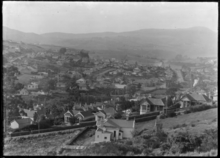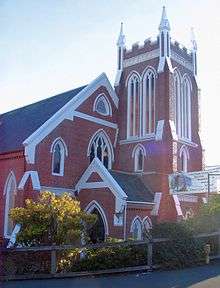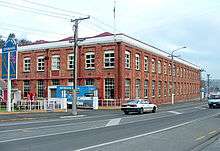Kaikorai Valley
Kaikorai Valley is a long broad valley which runs through the west of the New Zealand city of Dunedin, 5 kilometres (3.1 mi) to the west of the city centre. It is the valley of a small stream, the Kaikorai Stream, which runs from northeast to southwest down the length of the valley.

The valley provides a route into central Dunedin (Kaikorai Valley Road) which avoids the steep climb and descent over Lookout Point into Caversham, instead allowing for a gradual climb to the top of Stuart Street at Roslyn before a steep drop into the heart of the city. The valley contains several suburbs, largely isolated from the city centre by the ridge which forms the valley's eastern edge. This ridge was part of the crater wall of the long-extinct Dunedin Volcano.
The valley is largely occupied by light industrial and wholesale businesses. Much of the land to the west of the valley is semi-rural; the eastern wall contains residential properties.
The valley is home to three distinct suburbs: Kaikorai, Bradford, and Kenmure, while a fourth suburb, Burnside, lies at the valley's mouth, close to the junction of Kaikorai Valley Road and the Dunedin Southern Motorway, part of State Highway 1.
Kaikorai

The suburb of Kaikorai sits at the head of the valley. This suburb is largely residential, sitting close to the junction of Kaikorai Valley Road and Stuart Street, to the west of which Stuart Street becomes Taieri Road. Taieri Road links with the outer suburbs of Halfway Bush and Helensburgh before traversing the rugged Three Mile Hill, eventually emerging on the Taieri Plains. A complex junction links Stuart Street, Taieri Road, and Kaikorai Valley Road, and also provides a link with Highgate, the main road through the suburbs of Roslyn (which lies on the ridge immediately to the east of Kaikorai) and Maori Hill. The suburb of Wakari lies immediately to the northwest of Kaikorai.
Notable features of Kaikorai include a KFC restaurant, a bowling alley and a sports ground, Ellis Park. Close to the southern end of the suburb is a significant road junction linking Kaikorai Valley Road with the suburb of Brockville to the west.
Bradford

Bradford is a smaller, more ill-defined suburb lying in the centre of the Kaikorai Valley and in a small series of streets which lie immediately to its west. Like other parts of the lower valley, it contains numerous commercial properties such as wholesalers and car yards. Bradford Primary school lies in the suburb, which is named after Bradford in Yorkshire, England, because of its important textile mill industry.
A road junction close to the boundary of Bradford and Kaikorai close to the former mills links Kaikorai Valley Road with Stone Street, which rises rapidly to the east to meet the ridge at Belleknowes. A disused quarry is a notable feature on this road.
Kenmure
Kenmure occupies much of the lower valley and the slopes immediately to its east which straddle the land between Kaikorai Valley Road and Mornington Road. Most of these properties are reached by either Kenmure Road, which climbs the hill to join these other two roads, or by one of the streets which lead off it. This large suburb is predominantly residential, although it contains more wholesale commercial properties, some light industrial works, and several car sales yards, all on Kaikorai Valley Road. The suburb is linked via Mornington Road with the suburbs of Mornington to the north and Balaclava to the south.
A major feature of Kenmure is one of the city's larger secondary schools, Kaikorai Valley College (formerly Kaikorai Valley High School and Kenmure Intermediate School), which lies on Kaikorai Valley Road.